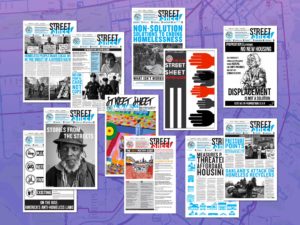by Jordan Davis
In November of 2022, I voted no on the charter amendment to create a Homelessness Oversight Commission in San Francisco. But I am secretly glad it passed, because it is yet another forum where I can criticize the government. It is good that the Department of Homelessness and Supportive Housing is on the hot seat.
Every meeting, I enjoy reading the director’s report and highlighting various details of programs, what the department is doing, and point out what it can be doing better. In this month’s report, I noticed that the Ending Trans Homelessness program would include a scattered site plan where homeless people would be housed in privately owned apartments that are run by several nonprofits that serve the trans community well.
Many trans people in the homeless population have medical needs that require us to be not only housed, but housed in a place that has at least rudimentary cooking and storage facilities, a private bathroom, and preferably, easy access both to recovery care and to support outside of surgery, as we face harsh challenges.
But, in the broader sphere of supportive housing in San Francisco, why can’t scattered site housing be the rule instead of the exception?
In the Chronicle’s “Broken Homes” series in 2022, the first installment concerning conditions within city-funded SROs referenced scattered site supportive housing as both a possible solution and a best practice employed in various locales, especially on the West Coast. The second installment concerning evictions referenced Project Welcome Home in Santa Clara, in which some homeless people with particularly acute needs are housed in a scattered site model to great success, even if it takes a few tries. San Francisco likes to think of itself as a global city, but often won’t even consider good policy from a city only a Caltrain ride away.
There are plenty of arguments for scattered site supportive housing, The first is that not every homeless person who is housed can succeed in a downtown SRO with strict visitor restrictions, no private bathroom, many other tenants who may or may not be decompensating, a physical plant that is falling apart, operated by a non-profit that has a culture of paternalism and that does not employ best practices, and an active drug market just outside. Perhaps the person who can’t succeed in an SRO in the middle of the Tenderloin or Sixth Street can succeed in an apartment on the Westside with wraparound case management and links to services, as an example.
There is also a chance that, in this tough fiscal climate, scattered site supportive housing may be considerably more cost effective. Soon after the first Chronicle exposé, the mayor pledged $67 million for improvements to troubled buildings and raises in staff pay, which many of us support—but this is not going to be sustainable in the long term. I have spoken with a member of the Homelessness Oversight Commission—whom I won’t name to protect their privacy—who told me that there is a possibility that the cost of housing people in some of the larger and more troubled sites may not be worth it, and that there may need to be a just transition out of some of these SROs for tenants. This transition would be similar to how the Baldwin Hotel, an extremely troubled SRO where tenants had tiny rooms and no in-unit bathrooms, was converted into a non-congregate shelter, and tenants were moved to other sites, including an SRO that was smaller and had private bathrooms and cooking facilities in each unit, except they would move into apartments across town.
There are some who would say landlords aren’t willing to provide housing to formerly homeless renters. However, as of January 1, 2020, state law bars landlords from discriminating based on the source of a renter’s income. There are some who would also say that supportive housing increases criminality in neighborhoods, however, study after study shows that it actually doesn’t have an impact on overall criminality, and actually helps create public safety by discouraging criminality and creating a sense of purpose. Furthermore, a scattered housing program would be in line with the Housing First philosophy, encouraging recovery without sobriety requirements and disrupting the drug trade near downtown supportive housing sites.
And this brings me to a lot of the toxic discourse on X/Twitter calling for an abolition of Housing First, replacing it with “Shelter First.” In the long run, focusing on shelters would be more expensive, inhumane and potentially traumatizing. As strongly as I believe in Housing First based on my own experience, I also think that we should also be smart about it: In other words, we need to mend it, not end it.
If San Francisco adopts scattered site supportive housing as a practice, it would use existing resources to create a safer and more cost effective system for tackling homelessness. As San Francisco faces a budget crisis, perhaps it is time to be smart and not cave into toxic discourse to solve our city’s issues. If maintenance of downtown SROs is too expensive, then perhaps it’s time to offer subsidies to tenants for moving into better housing. I have a feeling most would accept.

